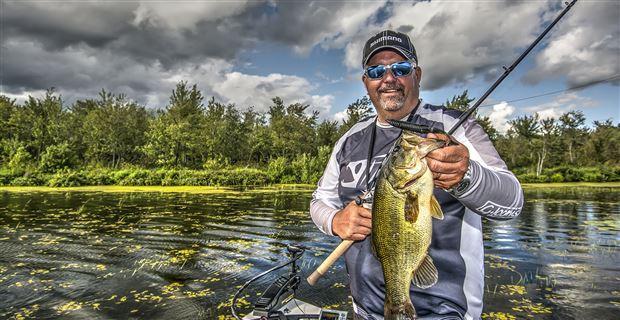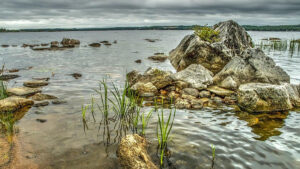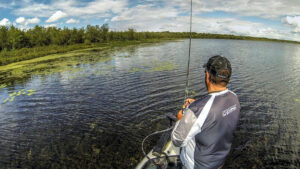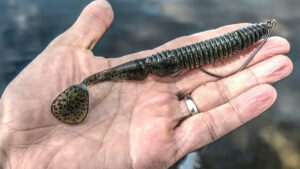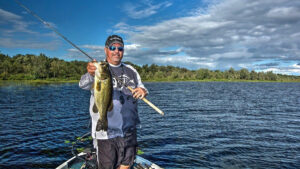Fluctuating water levels in a river can make it difficult to find and catch largemouth bass. When the water is high, a good rule of thumb is to avoid the murky, cool main river channel and fish shorelines within backwater areas where the water is less dingy and temperatures are more stable. When the water drops, bass pull away from the bank and move to deeper cover, like the outside edge of lily pads. Following this “in-when-up, out-when-down” basic principle can lead you to a lot more bass from rivers during sudden water levels changes caused by heavy rain or hydro-dam discharges.
Craig Lister’s a successful competitive angler with 30-years experience fishing largemouth bass from many of Ontario’s rivers. The following 6-part breakdown discusses how he fishes backwaters for largemouth when river waters rise or fall:
- High water: causes and impacts
- Hotspots
- Tactics
- Low water: causes and clues
- Locations
- Tactics
High water: causes and impacts
The larger the volume of water and the faster it enters the river, the more topsy-turvy a largemouth’s life becomes as water levels rise. On the rivers Lister fishes, sudden increases in water levels are typically the result of heavy rainfall more than from dam outflow.
Rain brings muddy runoff into a river. Perhaps the most temperamental system Lister fishes is the Ottawa River. The main channel can resemble chocolate milk after heavy rainfall. When this dirty, the Ottawa has a reputation for humbling even the region’s best bass anglers.
High water hotspots
“When a river rises, the most important thing to do is get out of the muddy water,” Lister said. “You’ve got to stay away from tributaries and get off the main channel. I go into back bays, looking for clearer water.”
Marshy, vegetation-rich backwaters are a river’s filtration system. It’s here, within these back bays, sloughs and connected lakes, where an angler has the best chance of finding clear water.
Stumps, rocks, cattails and other cover found within pockets of clearer water hold bass, especially if forage is present. These areas still tend to produce in high waters.
Stable water temperatures also make backwater areas more attractive. Heavy, cold downpours will lower a river channel’s temperatures and temporarily shutdown the bass fishing.
“I’ve seem the Ottawa’s main channel drop 10 degrees in a week,” Lister said. “Bass hate this kind of cooling temperature swings and will shut down.”
If you can’t fish backwaters, look for sheltered stretches of river away from and the main channel. The water opposite the channel behind points and bars is one place to explore. Vegetation filters sediment, making an inside grass line and the water behind it more productive.
5 high water tactics
Lister uses a variety of high-water tactics. Here are 5 reliable methods to catch more bass:
1. Fish closer to the bank
“When high water floods shorelines, suddenly a bunch of new critters become part of the food web,” Lister said. “Bass that were shallow will move closer to shore to eat snakes, rodents and frogs. Fish tuck into flooded timber and other areas where there usually isn’t water. Don’t be fooled. Not all bass will head ultra-shallow when the water rises. A good rule of thumb is to start fishing on the outside edges of shallow cover, making your way to the bank.”
2. Start with search baits
“Bass can be anywhere the first few days of high water, so I use reaction baits to find them,” Lister said. Top choices are bladed swim jigs, buzzbaits, spinnerbaits soft-bodied frogs, and swimbaits. Lister likes the responsiveness of G. Loomis’ E6X swimbait and crankbait rods for several of these presentations.
3. Think white and bright
Use white, bone and pearl baits in stained or muddy water. Lister finds largemouth key-in on these shad-based hues in dirty conditions.
4. Go slow
When thick cover demands a slow, methodical approach, Lister pitches plastics. He’ll use a Texas-rigged 4 or 5-inch crayfish, an 8-inch lizard or a 6-inch creature bait. A 1/4- to 1/2-ounce bullet weight is used to provide a slow fall. The goal is to give a bass plenty of time to react in the dingy water.
5. Try weightless
Lister often Texas-rigs a Jackall Cover Craw backwards without a weight. The bait falls slow and glides outwards as it sinks, which helps work more water underneath cover. Using a G. Loomis GLX 852S JWR spinning rod, Lister tosses and skips the weightless bait around and under cover. A 4000 sized Shimano Stradic CI4+ spools the 20-pound PowerPro Zero Impact and 20-pound P-Line fluorocarbon leader.
Low water: Causes and impacts
“When the water drops, bass are more predictable than when it’s high,” Lister said. “They pull away from the shore and shallows to feel safe and to follow the food source. Many anglers don’t realize this can happen in a day when dams lower water levels.”
It all starts at the boat launch before taking to the water. Lister looks for water lines on rocks, docks, bridge pilings and the boat ramp cement pad. Take note if the base of cattails are yellow or green. Yellow indicates low water for a period of time. Increased current flowing out of backwater areas is another indicator water levels are dropping.
At the end of the day, Lister compares his morning dock data to the afternoon water levels. Several times on large rivers controlled by hydro dams, he’s noticed a huge difference in water levels.
“In the morning, the water has overflowed into the parking lot surrounding the dock area,” Lister said. “At the day’s end the water has declined making it a dry walk off the dock to the truck.”
Low water locations
The outside edge and points of floating mat, arrowheads, lily pads and grass beds are the first places Lister fishes during low water. These deep, vegetation edges act as a boundary line to collect bass leaving the shallows.
“Also good are flats adjacent to where largemouth were holding prior to water levels dropping,” Lister said. “Flats are where the baitfish are going to go in low water, and the bass follow them.”
Old creek channels are another low water location. Expect bass to collect around timber, rocks and other features along the trough.
4 low water tactics
While low-water largemouth are more predictable, don’t expect them to jump in the boat. Lister offers these 4 tips to catch more bass.
1. Be thorough
River largemouth can hold very tight to cover because it creates a current break. In northern rivers, bass also hug cover to avoid being eaten by northern pike and muskie. Given this, it’s important to fish spots thoroughly.
“It has happened many times,” Lister said. “I’ve made a bunch of pitches to an area, and I think I’ve worked it over pretty good. Then I make one more pitch to a slightly different spot, and I hook a largemouth.”
2. Don’t discount small cover
On backwater flats, big largemouth will hold on compact pieces of cover, such as isolated lily pads or a patch of reeds. While they may look unassuming, you need to cast to these remote pieces of cover.
“Something as small as a stick can hold a 5 pounder,” Lister said. “This subtle stuff is what you’ve got to look for on flats.”
3. Work the current
Dropping water levels change current dynamics in backwaters. When water’s being sucked out of a bay, fishing current breaks around these outflow areas is a good strategy. Bass will position in current breaks, waiting to ambush prey swept-up in the fast water.
4. Cast a stick bait
When the chips are down, Lister casts a Texas-rigged 5-inch stickbait during low water. Edges of emergent vegetation, grasslines, stump fields, flats, creek channels and rock piles are all spots Lister fishes with this soft bait.
The next time water levels change on your favorite river, remember Lister’s tips and the “in-when-up, out-when-down” principle. Do this, and you’ll catch a lot more largemouth bass from rivers during fluctuating water levels.


